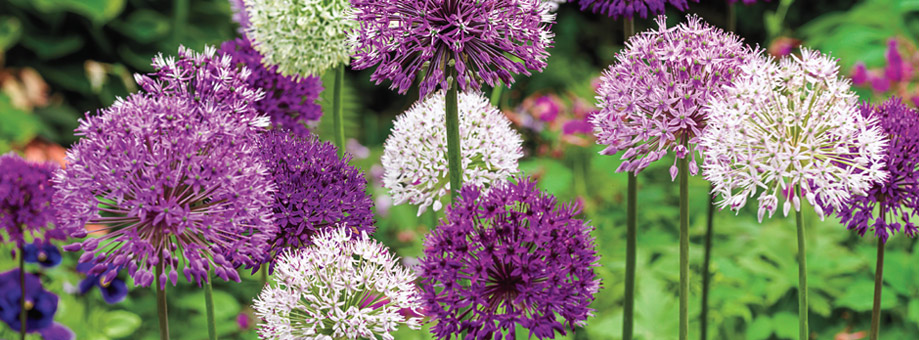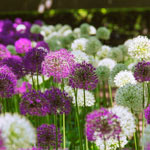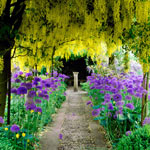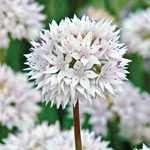- About Bulbs
- Landscaping Tips
- Planting & Care of Bulbs
- Tips for buying Bulbs & Perennials
- Planting & Growing Instructions
- Allium Planting and Growing Tips
- Astilbe Planting and Growing Tips
- Begonias Planting and Growing Tips
- Calla Lily Planting and Growing Tips
- Crocus Planting and Growing Tips
- Daffodil Planting and Growing Tips
- Dahlia Planting and Growing Tips
- Daylily Planting and Growing Tips
- Gladiolus Planting and Growing Tips
- Hosta Planting and Growing Tips
- Hyacinth Planting and Growing Tips
- Iris Planting and Growing Tips
- Lily Planting and Growing Tips
- Peony Planting and Growing Tips
- Rose Planting and Growing Tips
- Tulip Planting and Growing Tips
What is an Allium?
Alliums is a genus of plants containing many ornamental and edible plants—onions, shallots, garlic and scallions are all part of the Allium genus. In ornamental gardening, an allium is simply an ornamental that falls into this wide and wonderful group of plants. Known for their height and beautifully globe-shaped flowers, alliums are some of the most interesting bulbs in the spring and summertime garden.
Ornamental alliums are related to the amaryllis, and have a somewhat similar growth pattern, towering high above shorter garden plants. Alliums are popularly grown in pleasing shades of white, violet, and even green. In bloom, their florets form in a spherical shape, and are excellent attractors of bees, hummingbirds, and butterflies. Those flowers can range in size from diminutive to softball-size, and alliums grow in a wide range of heights. Shorter alliums may stand under one foot tall, while the tallest alliums can reach 50 inches in height.
Alliums tend to bloom from late spring to early summer, and have a wonderfully long bloom time. Most varieties last anywhere from two to four weeks. Alliums are also excellent cut flowers, so don't leave these bobbing, whimsical bulbs out of your cutting garden. Easy-to-grow Alliums provide one of the most effective ways to ensure continuing color and beauty in your garden after spring-flowering bulbs have faded. While you wait for the cheery blooms of summer flowers, it's easy to enjoy the outstanding features of Alliums:
- Exceptionally easy to grow with little concern for soil conditions.
- Intriguing, unique character of blooms that are a delight to behold.
- Great ornamental value after flowering. The flower heads of alliums continue to provide an interesting display even after the colors have faded.
- Great in dried arrangements.
- Ability to naturalize exceptionally well by multiplying year after year for increased beauty.
- Distasteful flavor for animals, so they won't eat any part of them.
- Alliums are attractive to hummingbirds!
Where to Plant Alliums
Alliums fit into almost any garden setting! Thanks to their in-between-seasons bloom time, these bulbs provide a much-needed bridge of color between spring and summer flowers. Allium naturalize beautifully, and can make amazing back-of-the-border flowers due to their stance and shape. One of our favorite benefits of growing alliums? An allium field is truly a pollinator's paradise.
Alliums really look best in the company of other summer bloomers. Sweet alyssum, rock cress, bachelor's buttons, coreopsis, sweet William, foxglove, baby's breath, daylily, iris red hot poker, coralberry, barberry, Japanese Maple, Deutzia rosea, weigela, and Geranium pretense are just some of the companion plants that look fantastic with Alliums.
Alliums do best in full sun with well drained, fertile soil and good moisture. Choose a location that receives at least six to eight hours of sunlight per day, and where water does not pool. These are great plants for xeriscaping, as they grow deep roots and don't mind bright sunlight.
Alliums can be grown in containers, but keep in mind that most alliums require a good bit of planting depth. If you're planting a taller allium, make sure to provide at least 8 to 10 inches of soil, and plenty of space for the plant to grow tall. Alliums don't have a wide spread, so they can be planted fairly close together.
When Should I Plant Allium Flowers
Alliums bloom in late spring or early summer, but the right time to plant alliums is in fall. Wait until after the first frost, but get your bulbs into the ground before the soil is completely frozen. By waiting until cooler weather to plant your alliums, you'll reduce the risk that they'll sprout too early and experience frost damage. And, they'll still have enough time to settle into the ground before the cold winter season.
In most of the U.S., the right time to plant allium bulbs is in September or October. Use our Zone Finder to determine the best time to plant allium in your growing zone.
How to Plant Allium Bulbs
Now that we've determined where and when to plant alliums, let's get to planting. Alliums are extremely easy-care bulbs right from the start, and planting alliums is a breeze. Let's look at how to do it.
- Alliums are best planted in fall, usually in September or October. Plant allium after the first frost, but before the ground has gone completely solid. These bulbs need enough time to establish a little rooting before the deep cold of winter, and they'll come up in spring.
- Choose your planting location. Pick a spot in the garden with well-draining soil, and make sure that the planting location you choose receives at least six hours of sun per day.
- Determine spacing. Most alliums require just four to eight inches of space for each bulb—alliums don't have a wide footprint, and can be planted relatively close together. However, they do need a bit of breathing room to become properly rooted.
- Work your soil. Use a hoe or spade to break up the soil in your planting location, and mix in compost, peat moss, or another drainage-improving material if you find that your soil is compacted or clay-heavy. Break up your soil to at least a foot of depth, so that your alliums' roots aren't fighting through hard, rough soil.
- Plant your allium! A good rule of thumb is to plant about two to three times the height of the bulb. Because allium varies so greatly by species, your planting depth depends upon variety. A small one-inch-tall bulb will be best planted at 2 to 3 inches, while a giant three-inch-tall bulb could be planted up to 9 inches deep. Dig individual holes using a spade, and backfill carefully. Remember that your bulbs should be point-up!
- Water in your alliums well. You won't need to water again over the winter, but begin watering regularly once the plants sprout in spring. In general, your alliums' soil should be moist, but not soggy, to the touch. If you experience a dry spring, you may need to water weekly.
Now you just need to sit back and wait for spring to arrive! After your alliums have bloomed, wait until the leaves die back on their own before cutting them back. Alliums, properly cared for, will come back year after year. And, these plants require no lifting in most zones!
What are Common Allium Pests and Diseases
Aside from the occasional snail and slug, alliums are, for the most part, pest and disease-free. In fact, the scent of these bulbs is actually a deterrent for deer and rodents. The presence of allium can actually protect your other bulbs from damage!
Should you find holes in your alliums' leaves, the most common perpetrator is a slug or snail. Use diatomaceous earth, beer traps, or slug bait to relieve your garden of those pests. Garden pest spray for ornamentals can also help eliminate aphids, earwigs, and other pests.
What are Popular Allium Varieties
Alliums are available in a wide variety of shapes and sizes. Here are a few of our favorite garden-worthy allium varieties. Mix and match to create an all-allium garden, or choose the colors and heights that coordinate with other perennials and bulbs.
- For a compact allium standing about 12 inches tall, In Orbit Allium is an excellent choice. These light purple blooms stand beautifully in the garden and dry out well for dried arrangements.
- Red Giant Allium lives up to its name in every way! Blooming in a deep magenta color with flowers nearly five inches across, this allium stands just 12 inches tall. The combination of large flowers and short stems is particularly charming in a cottage garden.
- Clusters of star-shaped purple-blue florets appear in large form on the Persian Blue Allium. Great for a cool-tone garden, Persian Blue stands out from the purple crowd.
- Graceful Beauty Allium offers large white florets with centers of purple. This allium features shining white petals in high-visibility form. A unique allium!
- A classic Drumstick Allium adds height and whimsy to the garden, with small flowers on stems 20 to 24 inches tall. These compact flowers bloom in a deep purple tone.
- Schubertii Allium stands out as a somewhat "exploded" allium. This unusual plant features nearly 100 individual purple florets on 16-18" stems that radiate from a ball-shaped center.
- For the pink-loving gardener, Rosy Dream Allium features a classic allium shape in a rosy-purple hue. Three-inch wide blooms stand out in the garden and in the vase.
Alliums come in all shapes and sizes and are lots of fun to grow! These easy plants sparkle in disco-ball form in neat rows or informal cottage gardens. There's an allium for everyone.
You May Like...













